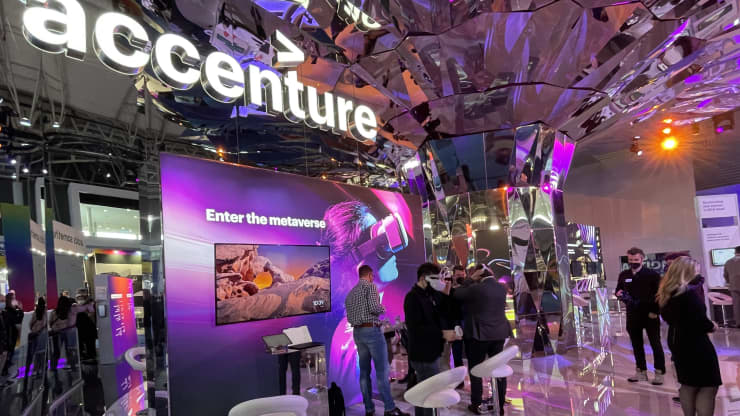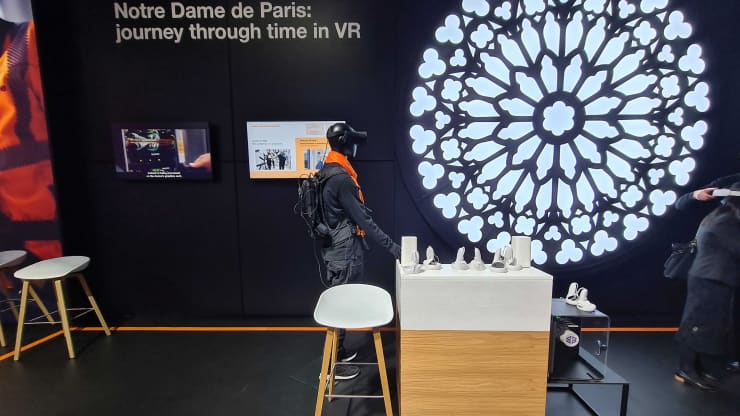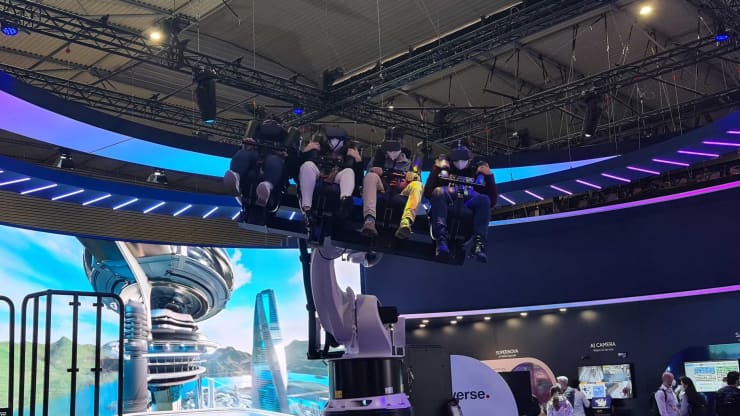“Metaverse” was the term on everyone’s lips at this year’s Mobile World Congress, the world’s biggest mobile trade show. It’s a hazy concept, but “metaverse” is broadly used to describe vast digital worlds in which users can work, play games or even party.
And things seemed to get even less clear at MWC. But analysts believe it’s here to stay.
ABOVE: SK Telecom’s “4D Metaverse” ride (yes, ride) at Mobile World Congress 2022 in Barcelona, Spain
BY:
Cassandra Este
Technology Reporter
PROJECT COUNSEL MEDIA
7 March 2022 (Barcelona, Spain) – The Mobile World Congress made a big comeback last week. Before I dash off to catch my flight back to Paris (after a beautiful weekend enjoying this marvellous city) just a few thoughts.
NOTE: GSMA (Groupe Speciale Mobile Association), the organisation that hosts MWC, cancelled the Russian Pavillion at the event, as well as banning a number of other Russian companies set to exhibit.
This year the term on everyone’s lips wasn’t “smartphones” or even “5G” (although I’ll make a few points about those further on). No, instead, it was the “metaverse” – that vague concept used to describe vast digital worlds in which users can work, play games or even party. The term has been the talk of the tech world ever since Facebook changed its name to Meta, a rebrand largely aimed at drumming up hype for Mark Zuckerberg’s vision for the virtual universe. And at MWC, the world’s biggest trade show for the mobile phone industry, the word was repeatedly dropped into keynote speeches and splashed across exhibition stands. It was the “buzzword of the moment” and most of the more-attuned analysts stressed it’s still quite a nebulous term. Because if the metaverse is already a hazy concept, things seemed to get even less clear at MWC.
South Korean firm SK Telecom had a “4D Metaverse” ride at its booth throughout the week. Attendees sat down on the ride and wore virtual reality headsets. They were then lifted up and carried around a digital representation of space. The catch? It was just another variation of the same 4D VR rides companies like Samsung have showed off at MWC in previous years. For a glimpse from 2017 feast your eyes on this:
In fact, many (most) of the metaverse experiences at MWC 2022 were VR-based. At HTC’s stand, visitors were invited to put on the Taiwanese company’s Vive headsets and walk around a virtual museum. They could also walk around in a small pen while exploring a desert landscape in VR. Over on the Qualcomm booth, you could get cooking lessons or swat giant 3D insects. Orange was inviting people to climb the Notre-Dame Cathedral in VR with Meta’s Oculus Quest 2 headset.


That’s the weird, wacky and the wonderful that was on show at MWC – everybody trying to jump on the bandwagon that is the metaverse. It all still feels very much far fetched. And it definitely does almost feel kind of “Wild West” right now.
Baby steps
Telecom companies have begun taking baby steps into the metaverse, with Spain’s Telefonica even appointing someone as its “chief metaverse officer” to bring the carrier’s metaverse strategy “to life”. What that strategy will be is unclear. Which the company pretty much admitted. In a MWC press conference the Telefonica press rep said:
“We are thinking about what should be the role of a telco like Telefonica in this new evolution. We don’t know yet. But for sure, we are going to be analyzing this very carefully because we believe that this movement is unstoppable”.
Not to be outdone, the UK’s BT said it hasn’t hired a chief metaverse officer just yet. Said the BT brand spokesman:
“At the moment, you can put the word metaverse in most things with job titles or initiatives and it sort of makes something that’s not yet that clear seem very modern and exciting. But it will be. The metaverse is a natural evolution of the internet, and some aspects of the metaverse already exist. Mixed reality experiences are being created today and they will evolve”.
Ironically, Facebook-parent Meta – which fired the starting gun on chatter about the metaverse – didn’t have much of a presence on the exhibition floor at MWC. But the company had a lot to say on its development. Zuckerberg put out a statement during MWC saying its metaverse ambitions won’t be possible unless there are drastic improvements in telecoms infrastructure. Dan Rabinovitsj, Meta’s vice president of connectivity, said today’s fixed-line and mobile networks aren’t yet ready:
“We’re working closely with our colleagues to think about what’s the next step in terms of mobile network innovation”.
Another thing that will require more investment going forward is chips. Semiconductor giant Qualcomm, for example, says chips will need to get smaller, faster and less power-hungry if the metaverse is going to work. Pretty much everyone who is making a metaverse device at this point is using a Qualcom chip.
Whatever the metaverse does eventually end up looking like, analysts believe it’s here to stay. As one said “we are at the beginning of a long journey”. And let’s face it. We’ve already had an interesting step in the right direction with the pandemic because we’re starting to live more blended lives. There will be elements of that which will lend themselves to a metaverse-like experience. But I think going to be a long, long time.

Mobile World Congress 2022 was our 15th appearance at the event, and the first without any of our video crews in tow because our EU based crews were filming at the Auschwitz death camp for our boss’ upcoming film, with the other handling filming assignments for our coverage of the Ukraine war.
But I can say MWC 2022 seemed a big success – mainly for people’s spirit and morale. The GSMA released preliminary attendance numbers at around 60,000, just a little less than half of what was recorded in 2019, the last time the industry came together before Covid. The combination of people’s strong desire to return to normalcy as well as the need, especially for smaller companies, to have the opportunity to showcase their capabilities will continue to make shows like Mobile World Congress a success.
It seems that what was already a show that thrived on closed-doors meetings doubled down on personal connections, which is what I expect most events to be doing post-Covid. Personally, I think the GSMA missed the opportunity to make the show even bigger by keeping the online portion of the show as strong as possible. Unfortunately, when it came to the conference sessions, the majority were offered as in-person only and did not cater to an online audience.
But I understand that. Yes, we learned during the pandemic about “democratizing access through technology”, to expand your audience through online experiences that add to the in-person ones. But MWC like Cannes Lions thrives on “in-your-face-meetings” and GSMA was clearly aiming to get back to normal. And if you have been to MWC you know the benefits of socialising at enormous conferences, visible here in the packed networking food/drink outside terraces (18 in number) and the inside coffee kiosks and meeting spaces (about 50) across the sprawling congress grounds. GSMA does not want you to leave the site so they have a huge number of one-to-one + group meeting sites + coffee/drinks/food sites inside and outside the exhibit floors. It is the way a technology event should be run.
There was the usual flood of consumer products like PCs and smartphones announced before the show, but I was keen to learn about future technologies such as 6G and Wi-Fi7 and enabling businesses to harness what is here today from 5G to Cloud – so I and the other members of our team spent a lot of time at Nokia and Qualcomm. We are also at a time when what has been the star of the show for quite a few years, 5G (in fairness, way earlier than it needed to be), has finally moved on from smartphones to connecting devices and experiences that drive a much bigger vision. From connected cities to cars to the cloud. While 5G is well established, most consumers have yet to experience it, which makes talks about 6G a tad premature. Fortunately, it did not feel that brands were hyping that, and more time was spent talking about 5G network optimization for both consumers and enterprises, public and private.
So I spent a good chunk of my time with mobile network vendors to get updated on the complete infrastructure and components that underpin mobile technologies, to make it more digestible for our readers.
And while we might smile or roll our eyes at the mention of 6G, there are a couple of things worth bearing in mind.
First, the world is headed to be more and more digital. The metaverse I discussed above will require super connectivity no matter how you think of it. While that connectivity is Wi-Fi7, 5G or 6G will depend on location, network coverage and cost. But there is no question that the world will need more connectivity, not less. In the meantime, we talk about optimizing networks and infrastructure, of devices working more together to deliver a better user experience.
Second, the transition from 5G to 6G will be more evolutionary in nature than that from 4G to 5G, which might result in a shorter time to market as business models are being worked out now.
And a big change: the show was relatively light on American participants, still due to some of the travel complexities. This meant we didn’t have many consumer brands that we have recognized in the past, such as Meta and Netflix or that brands like Google had a smaller presence. Interestingly cloud vendors such as AWS had a considerable presence at the show, possibly pointing to the fact that it mainly was consumer brands that stayed away possibly because of the more challenging European regulatory environment. Of course, the economy and the recovery from Covid-19 also require a bigger focus on business, both from how companies have evolved during the pandemic and new opportunities that digital transformation has opened up for businesses.
And the show was clearly also a bridge between two realities: the pandemic and the promise of crypto, Metaverse and NFTs. Especially from a devices perspective, we saw PCs in the limelight following the resurgence experienced in the pandemic and the desire for OEMs to keep the momentum with the introduction of devices that fit hybrid work and a higher volume of digital workflows.
If I had to pick winners and losers of the show, I would certainly say the people attending and the industry won, but there was not a clear brand or theme that won. It was clear to me that the current geopolitical environment and the great suffering from the pandemic have put some sense of sobriety on what many companies have been focusing on. This meant that we saw a greater emphasis on big societal issues and how technology can help address them. Top of the list was sustainability, connecting the unconnected and driving digital equity.
